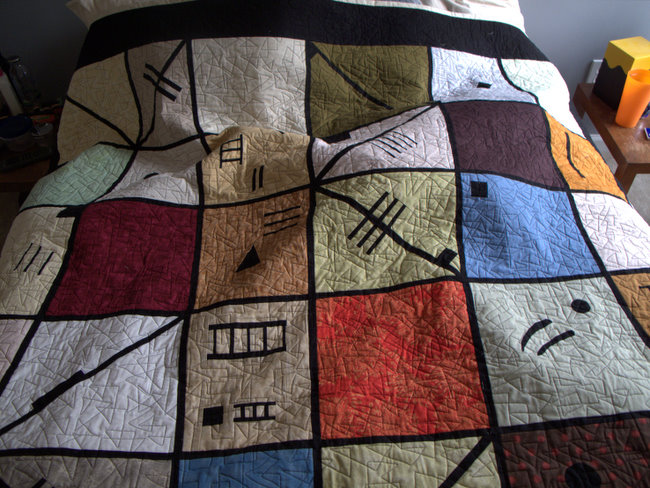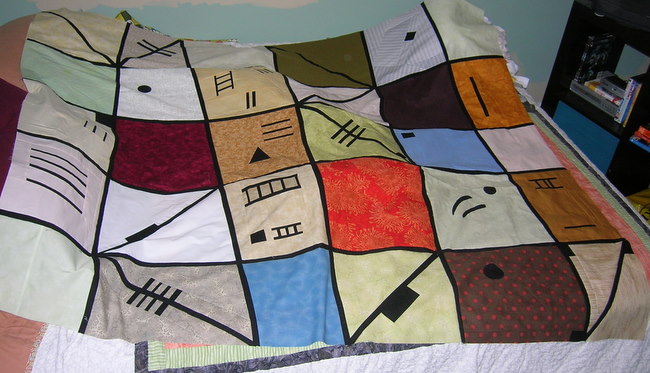Thousands of tiny stitches: my first quilt
One day in April or May of this year, I was sitting in the living room at my parents' house perusing some quilt books (my mother owns plenty) when Ben and I came across what would become my summer (and 2009) project. The modern design of the quilt he chose (it was to be his Christmas gift) was created by a quilter named Dixie Haywood that was featured in the 2000 book Quilting Masterclass: Inspirations and Techniques from the Experts.
 This design, "Soho Sunday," would pose a particular problem to my mother and me upon beginning: the asymmetrical rows of uniquely-shaped quadrilaterals meant there was no simple pattern by which to guide me. The book didn't give any sort of pattern, nor dimensions; as far as size, we measured another full-to-queen-sized quilt and then looked around to find something we could use as pattern pieces. We found some leftover pieces of 13x20 (or so, not sure exactly what size those are) poster board that my youngest brother had used for a class assignment. Tape three pieces together lengthwise, and boom, we had one row across. Do that nine times, you've got nine columns. For each row, I matched the angle I had cut in the one above it so that when combining rows later on, they would match up. We started the angles for the columns just on our eye, making sure the angles weren't too large that the bottom would end up looking silly with distorted rhombuses.
This design, "Soho Sunday," would pose a particular problem to my mother and me upon beginning: the asymmetrical rows of uniquely-shaped quadrilaterals meant there was no simple pattern by which to guide me. The book didn't give any sort of pattern, nor dimensions; as far as size, we measured another full-to-queen-sized quilt and then looked around to find something we could use as pattern pieces. We found some leftover pieces of 13x20 (or so, not sure exactly what size those are) poster board that my youngest brother had used for a class assignment. Tape three pieces together lengthwise, and boom, we had one row across. Do that nine times, you've got nine columns. For each row, I matched the angle I had cut in the one above it so that when combining rows later on, they would match up. We started the angles for the columns just on our eye, making sure the angles weren't too large that the bottom would end up looking silly with distorted rhombuses.
For color scheme, I wanted to keep the palette close to the pastel and pale dominating colors that bound the original quilt, because that base is what makes all the bold squares really pop. Right as the fall semester was starting, I finished the eighth and final row on the quilt front (nine would have made it disproportionately long, so I opted to stop at eight). A few weeks later, I bought the backing fabric, a funky Amy Butler design I found at my local Red Hen Fabrics. My mom taught me a mitered corner, and I successfully created a bold black frame around my quilt front. It was ready to be quilted.
 Around mid-November, I brought the quilt and backing fabric in to Alta at Red Hen, their professional quilter, who took a particularly difficult and unique stitching design and bound these two layers around their batting, creating the black graphic motif that was essential to the entire mood and design of the quilt. Black had bound each square to its brother, each row to its neighbor, and all of them into a cohesive work of art; now it would wind its way throughout each little canvas of color.
Around mid-November, I brought the quilt and backing fabric in to Alta at Red Hen, their professional quilter, who took a particularly difficult and unique stitching design and bound these two layers around their batting, creating the black graphic motif that was essential to the entire mood and design of the quilt. Black had bound each square to its brother, each row to its neighbor, and all of them into a cohesive work of art; now it would wind its way throughout each little canvas of color.
She called me with the good news about three weeks ahead of my estimated completion date, which meant that after everything, I was going to finish the job in time for Christmas. All that was left was the binding, which I again learned from my mother. I used a nice stone-colored fabric for the binding, and hand-stitched the entire back side as I learned this final step.
The entire quilt was a learning process. Every little technique was taken into this larger project as an essential and important skill, one that must be accurate and provide the professional touch that learned quilters look for. Learning from my mother, there was no way I could do things in an amateur way, which is why piecing each square was just as important as reverse applique, and little things like seam allowances had to be accurate. Those skills translate into many other areas of sewing and design, and knowing how things are made when I see them only makes me want to start all over again with a new design. But I'm not quite so crazy; I'll give it a few months at least. I have mastered the mitered corner (OK, I've only somewhat grasped it) and learned some tips and tricks on making a professional-looking doubled-over binding. Along the way, I also bought my own sewing machine (having grown up using my mom's trusty Viking) and have definitely mastered threading and cleaning that thing.
 This quilt has been a labor of love, and it has been guided under the loving tutelage of my mother, who has studied and created some amazing quilts herself. It has been rewarding in more ways than the resultant blanket on the edge of a bed, and has really brought me further into a realm I have always hung near only by association with my mom. More years of projects like this and much smaller ones as well provide us both the companionship and satisfaction of the craft and help further my own personal identity within textile arts. I don't have the goal of matching my mother, but simply of absorbing everything I can from her breadth of knowledge so that I have the ability to create, to add to the things that surround and inspire me.
This quilt has been a labor of love, and it has been guided under the loving tutelage of my mother, who has studied and created some amazing quilts herself. It has been rewarding in more ways than the resultant blanket on the edge of a bed, and has really brought me further into a realm I have always hung near only by association with my mom. More years of projects like this and much smaller ones as well provide us both the companionship and satisfaction of the craft and help further my own personal identity within textile arts. I don't have the goal of matching my mother, but simply of absorbing everything I can from her breadth of knowledge so that I have the ability to create, to add to the things that surround and inspire me.







